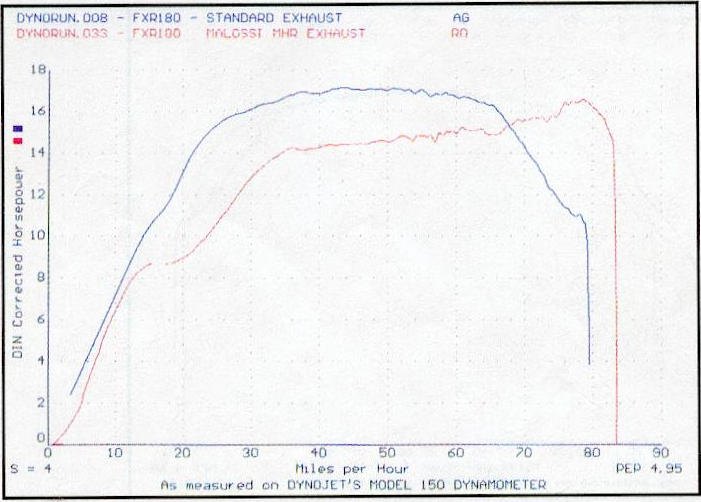

|
The point of this article is to show exactly what performance to expect from any of these exhausts if they are bolted onto a standard Runner/Dragster 180. These results are largely irrelevant once you get involved in tuning and fitting kits, because the higher revving exhausts may then be better suited to the engine's characteristics, In all the subsequent graphs, the standard exhaust is represented by the blue curve and the compared exhaust is shown by the red curve.WHY REPLACEYOUR EXHAUS? On a standard 180 Runner /Dragster, only the PM and Stoffi pipes provide a worthwhile performance improvement. Considering that we have tested samples from the cream of Europe's tuning houses , then this really does go to show how far the development of original equipment silencers has come in the last few years and particularly how fussy the 180 Runner engines is to pipes. |
Even the less powerful exhausts may still have some thing to offer. The original Gilera exhaust is extremely heavy, prone to rusting and in some rare cases can even break along the bottom part of the bracket. When this happens (usually heralded by a new vibration felt on the machine) all the weight oft the exhaust is supported by the top mounting bolt which can-if not dealt with quickly-break the top mounting lug off the engine. Apparently later exhaust feature brackets with strengthened welding but like all exhausts, even those will have a finite lifespan. For all its excellent performance, you will have to pay around £230 to replace a complete genuine Runner Considering that you can have more power for the same sort of price with a Stoffi or PM exhaust, both of which look and sound sportier, it seems you might as well do so . Alternatively for around the same sort of price - when they arrive in the UK - you could have a DIG wich gives you a similar power output to standard, but a higher top speed thanks to a revvier delivery. This comes of the cost of having to modify your transmission with the bits provided, |
and to the detriment ofthe life of your engine since it is having to run at higher rpm all of the time. If you just want something cheap to replace a broken original pipe - and arent worried about loosing 1.3 hp - then the best bet from this bunch appears to be the Kundo for £150. As for all the others, then the simple answer is mot to waste your money if you are simply looking for a simple boost to a standard scooter, because they will all make it perform worse in some way.NEXT ISSUE We also planned to include the Gianelli Freeway exhaust for the 180 Runner in this test, but the current batch for this model turned out to have been recalled by the distributor. There are also some systems wich we may hopefully manage to try if all the manufacturers and distributors are willing to play ball: the Kegra Racing exhaust, Sito Plus, and a bit of luck, a brand nea PM 55 Mk2 Whatch out for a part two soon. |
STD versus MALOSSIAvailability: Any V.E. Spares stockistPrice: £355 (Malossi Tech Centre price) 
|
STD versus PMZ PM 55 Mk2Availability: Direct from PM Tuningor via V.E. Spares stockist Price: £220 with alloy muffler; other muffler options available. 
|
Like the Polini pipe, the Malossi is designed as a race part
|
I know from experience on my own Runner that the
|
|
Malossi's pipe works well with their complete race set-up, but not on a standard engine. |
Better than standard across the range, and would have been better still if we'd had a new sample to test. |